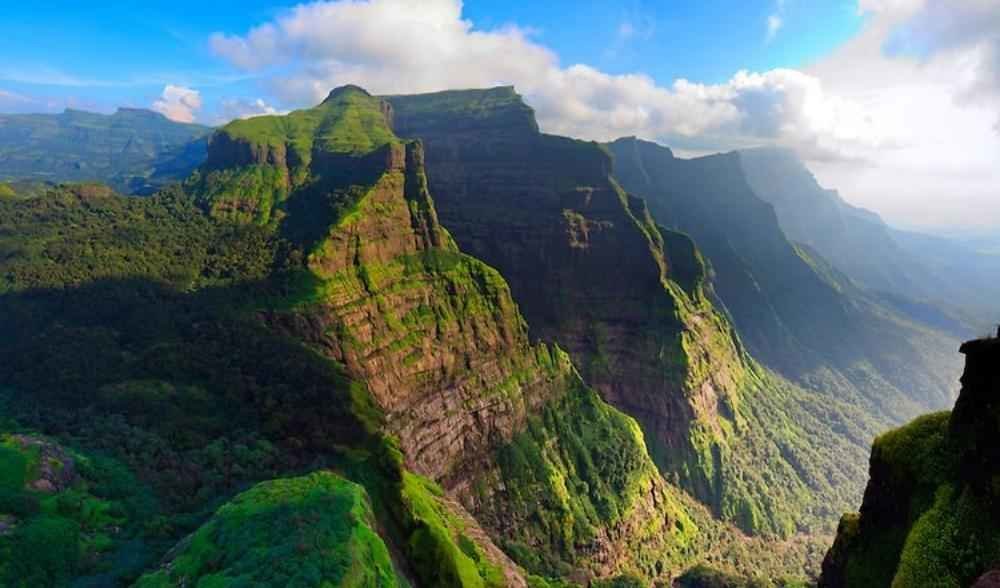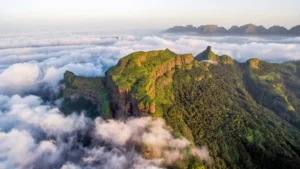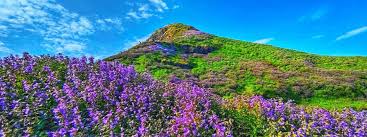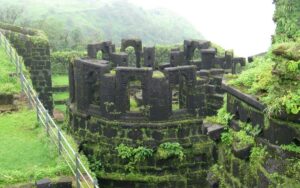
‘ ); } ?>
Table of Contents
Ratangad Fort

Ratangad Fort, also known as the “Jewel of the Sahyadris,” is a paradise for adventure seekers and history enthusiasts. Located in the Ahmednagar district of Maharashtra, this 400-year-old fort offers breathtaking panoramic views of the Sahyadri mountain range, including the famous Kalsubai Peak.
The trek to Ratangad Fort is a thrilling experience, with lush green trails, dense forests, and rocky patches adding to the adventure. One of the key highlights is the iconic “Nedhe” or the natural rock cavity, also called the “Eye of the Needle.” The fort’s ancient caves and bastions reflect its historical significance, once ruled by Chhatrapati Shivaji Maharaj.
Whether you’re a beginner or an experienced trekker, Ratangad Fort promises an unforgettable journey. The best time to visit is during monsoon and winter when the surroundings are at their scenic best. So, pack your bags and embark on this exhilarating trekking adventure.
History of Ratangad Fort
Ratangad Fort holds immense historical significance, dating back more than 400 years. The fort was originally controlled by local tribal kings and later became an important stronghold in the Deccan region. Chhatrapati Shivaji Maharaj, the founder of the Maratha Empire, captured Ratangad v from the Mughals and integrated it into his growing empire. Due to its strategic location overlooking the trade routes and surrounding valleys, Ratangad Fort served as a crucial military post for the Marathas.
During Shivaji Maharaj’s rule, Ratangad Fort played a vital role in safeguarding the Maratha territories and was used as a watchtower to monitor enemy movements. The fort witnessed several battles between the Marathas and the Mughals, who repeatedly tried to reclaim it. The fort’s architecture, including its strong bastions and fortifications, reflects the defensive prowess of the Maratha military engineers.
In the later years, as the Mughal Empire declined, Ratangad Fort continued to be an important fort under the Peshwas. However, with the advent of British rule in India, the fort lost its military significance and was eventually abandoned. Today, the ruins of the fort stand as a testament to its glorious past, attracting history enthusiasts and adventure seekers alike.
The fort still holds remnants of its historical past, including ancient stone structures, old water cisterns, and caves that once provided shelter to Maratha soldiers. The famous “Nedhe” or “Eye of the Needle,” a naturally formed hole in the mountain, adds to the mystique of this ancient fort. Legends and folklore surrounding Ratangad Fort continue to intrigue visitors, making it an essential destination for those interested in Maharashtra’s rich history.
Trekking Route and Difficulty Level
Ratangad Fort trek is considered a moderate-level trek, making it suitable for both beginners and experienced trekkers. However, the terrain varies based on the route chosen, and certain sections can be challenging, especially during the monsoon season.
Trekking Routes
There are two primary routes to reach the fort:
- From Ratanwadi Village – This is the most popular and scenic route, offering a balance between natural beauty and adventure. The trail passes through dense forests, waterfalls, and rocky patches, making it an exhilarating experience. The trek from Ratanwadi starts with a gradual incline, followed by a series of stone steps carved into the mountain. As you ascend, you will encounter lush greenery and breathtaking views of the Bhandardara region. This route is relatively easier and preferred by beginners.
- From Samrad Village – This route is more challenging and is usually chosen by seasoned trekkers. It involves a steeper climb with rugged terrain, making the ascent physically demanding. Trekkers on this route must navigate rocky paths and loose gravel, requiring better endurance and trekking experience. The reward, however, is an incredible view of the famous Sandhan Valley and nearby peaks.

Duration and Difficulty
- The trek takes approximately 3-4 hours to reach the fort, depending on your chosen route and pace.
- The initial part of the trek is relatively easy, with gradual inclines and well-marked trails. However, as you get closer to the fort, the path becomes steeper and more rugged.
- The final stretch to the fort involves steep iron ladders, which add to the adventure. These ladders are securely fixed but require careful navigation, especially during the monsoon when they become slippery.
- The descent generally takes 2-3 hours, but trekkers need to be cautious while climbing down the rocky sections.
Challenges Along the Trek
- Monsoon Risks: During the rainy season, the trails become muddy and slippery, increasing the risk of falls.
- Rocky Terrain: The last section before the fort is rocky and uneven, requiring steady footing.
- Steep Climbs: The ascent through iron ladders can be challenging for those with a fear of heights.
- Limited Water Sources: While some water cisterns are present at the fort, they may not always be clean. It is advisable to carry sufficient drinking water.
Best Tips for Trekkers
- Wear good-quality trekking shoes with strong grip to navigate rocky and slippery paths.
- Carry at least 2 liters of water as there are limited water sources along the trail.
- If trekking during the monsoon, bring a raincoat or poncho to protect yourself from heavy rainfall.
- Travel in groups, especially if you are a beginner, for added safety and support.
- Start early in the morning to avoid trekking in the afternoon heat and to have enough time for exploration at the fort.
- Pack some light snacks or energy bars to keep yourself energized during the trek.
Attractions at Ratangad Fort
1. Nedhe (Eye of the Needle)
One of the most famous attractions of Ratangad Fort is the “Nedhe,” a natural rock cavity formed due to wind erosion. This massive hole in the mountain offers mesmerizing views of the surrounding valleys and peaks. It is a perfect spot for photography and adds to the fort’s mystique. Legends say that the hole was naturally carved over centuries due to wind and water erosion, making it a geological marvel worth witnessing.

2. Ancient Caves
Ratangad Fort is home to several ancient caves, believed to have been used as shelters by soldiers and travelers in historical times. These caves, some of which have carvings on their walls, can accommodate groups of trekkers and are often used for overnight stays. Staying in these caves during the trek enhances the experience, giving trekkers a glimpse into how warriors might have lived centuries ago.
3. Fortifications and Bastions
Despite being in ruins, the walls and bastions of Ratangad Fort still hold historical importance. The fortifications were strategically built to withstand enemy attacks and provide security to the Maratha army. The design of the bastions showcases the architectural prowess of that era. Some sections of the fort still have old gates and stone-carved water cisterns, offering insight into the engineering techniques of the Marathas.
4. Bhandardara Backwaters View
One of the most breathtaking sights from Ratangad Fort is the stunning view of the Bhandardara Dam and Arthur Lake. On a clear day, you can witness the reflection of the mountains in the tranquil waters of the dam, making it an ideal spot for nature lovers and photographers. The sunrise and sunset views from the fort are particularly mesmerizing, adding to the trek’s magical experience.
5. Seasonal Flora and Fauna
During monsoon and winter, Ratangad Fort transforms into a paradise of lush greenery and vibrant wildflowers. The trail is dotted with exotic plants, moss-covered rocks, and gushing waterfalls, creating a mesmerizing landscape. The region is home to diverse bird species, butterflies, and small mammals. If you’re lucky, you might spot rare birds like the Malabar whistling thrush or the Indian paradise flycatcher. The trek is a delight for nature enthusiasts who love to explore rich biodiversity.
Best Time to Visit Ratangad Fort
Ratangad Fort offers different experiences in every season, making it a year-round trekking destination. However, the ideal time to visit depends on your preference for weather conditions and trekking difficulty.
Monsoon Season (June to September)
- The fort and its surroundings transform into a lush green paradise with cascading waterfalls and misty landscapes.
- The monsoon trek is ideal for nature lovers and photography enthusiasts who enjoy the sight of vibrant greenery and cloud-covered valleys.
- However, the trails can become slippery and challenging due to heavy rainfall, making the trek more difficult.
- Proper trekking shoes, raincoats, and waterproof gear are necessary to navigate safely during this time.
Winter Season (October to February)
- Winter is the best time for trekking to Ratangad, as the weather is cool and pleasant, making the climb more comfortable.
- The skies remain clear, providing stunning panoramic views of the Sahyadri mountain range, including Kalsubai Peak and Bhandardara Dam.
- This season is perfect for camping near the fort, as the caves and open spaces offer a cozy setting under the stars.
- The moderate climate also makes winter treks ideal for beginners and casual trekkers.
Summer Season (March to May)
- Summer treks can be hot and tiring, especially during midday when temperatures rise significantly.
- The best way to enjoy a summer trek is to start early in the morning or late in the evening to avoid the heat.
- The landscapes are drier, but the views from the top remain spectacular, especially during sunrise and sunset.
- Carrying extra water, wearing light clothing, and staying hydrated are essential for a comfortable summer trek.
Final Recommendation:
- For lush greenery and waterfalls: Monsoon (but be prepared for slippery trails)
- For clear views and comfortable trekking: Winter (best season for beginners and camping)
- For a challenging but rewarding experience: Early summer mornings or late evenings

How to Reach Ratangad Fort
By Road:
Ratangad Fort is accessible from major cities like Mumbai and Pune. The journey takes you through scenic landscapes, making the drive itself an enjoyable experience.
- From Mumbai (Approx. 180 km): Drive via NH160 to Ghoti, then take the Ghoti-Bhandardara Road leading to Ratanwadi, the base village.
- From Pune (Approx. 195 km): Take NH60 towards Sangamner, then continue towards Akole and Bhandardara before reaching Ratanwadi.
- From Nashik (Approx. 90 km): Drive via NH160 to Ghoti and then proceed towards Bhandardara.
Since public transport is limited, it is advisable to drive or hire a private vehicle. Parking is available at Ratanwadi village.
By Train:
For those relying on public transport, the nearest railway station is Igatpuri, approximately 50 km from Ratanwadi. Igatpuri is well-connected to Mumbai, Nashik, and Pune by regular train services.
- From Igatpuri, you can take a state transport (ST) bus or hire a private jeep to reach Bhandardara.
- From Bhandardara, local shared jeeps or private cabs are available to Ratanwadi, the starting point of the trek.
If you prefer an alternative railway route, you can also travel to Kasara railway station and then take a bus or taxi to Bhandardara before proceeding to Ratanwadi.
By Bus:
State transport buses operate from Mumbai, Pune, and Nashik to Bhandardara. However, the frequency is limited. From Bhandardara, you need to hire a private jeep or shared taxi to Ratanwadi.
Local Transport Options:
- Shared jeeps are available from Bhandardara to Ratanwadi, but they run infrequently.
- Private cabs or rented vehicles are the best options for a hassle-free journey.
Essential Trekking Tips
- Wear comfortable trekking shoes with good grip.
- Carry sufficient water and energy snacks.
- Wear weather-appropriate clothing (rain gear during monsoon).
- Start early to enjoy the trek and descent before dark.
- If planning an overnight stay, carry a sleeping bag and flashlight.
- Travel in groups for safety and better trekking experience.
- Respect nature and avoid littering the trail.
Conclusion
Ratangad Fort trek is a perfect blend of adventure, history, and nature, offering an unforgettable experience for every type of traveler. Whether you are a history buff fascinated by the tales of Chhatrapati Shivaji Maharaj, an adventure seeker looking for a thrilling climb, or a nature lover eager to soak in the breathtaking landscapes, this trek caters to all. The journey to the fort, with its winding trails, lush forests, and panoramic views, is as rewarding as the destination itself. The mystical charm of the ancient fort, coupled with its scenic beauty, makes Ratangad Fort a must-visit destination in Maharashtra.
Trekking to Ratangad Fort is not just about reaching the summit; it’s about embracing the raw beauty of the Sahyadris, feeling the rush of adventure, and immersing yourself in the serenity of nature. With every step, you are greeted by picturesque landscapes, echoing history, and an overwhelming sense of accomplishment.
So, if you’re looking for an adventure that combines physical challenge, historical intrigue, and natural splendor, Ratangad Fort should be at the top of your list. Pack your bags, rally your trekking buddies, and embark on this exhilarating journey to one of Maharashtra’s finest trekking destinations – the Jewel of the Sahyadris, Ratangad Fort
Ratangad Fort Map
Follow More Fort
